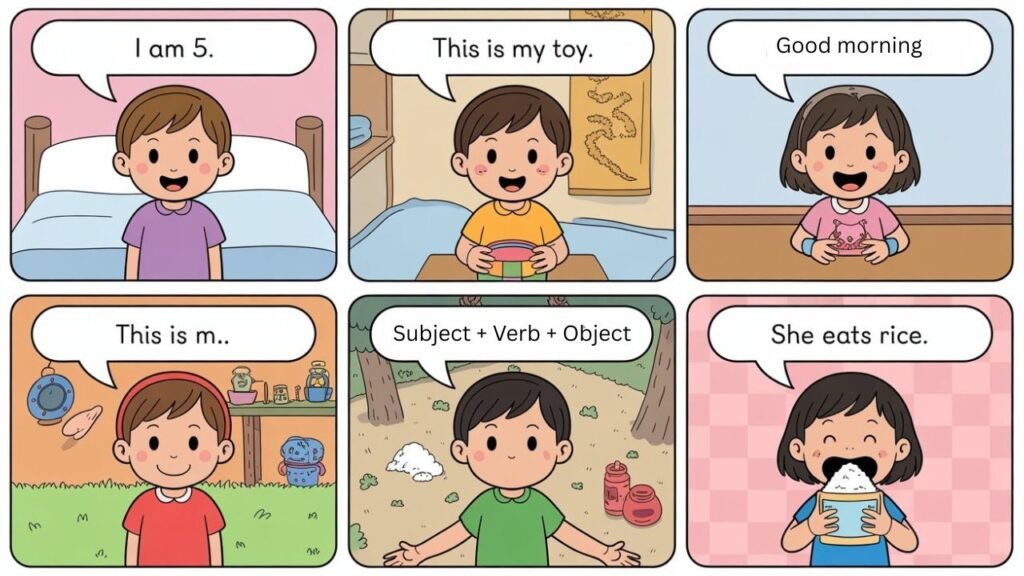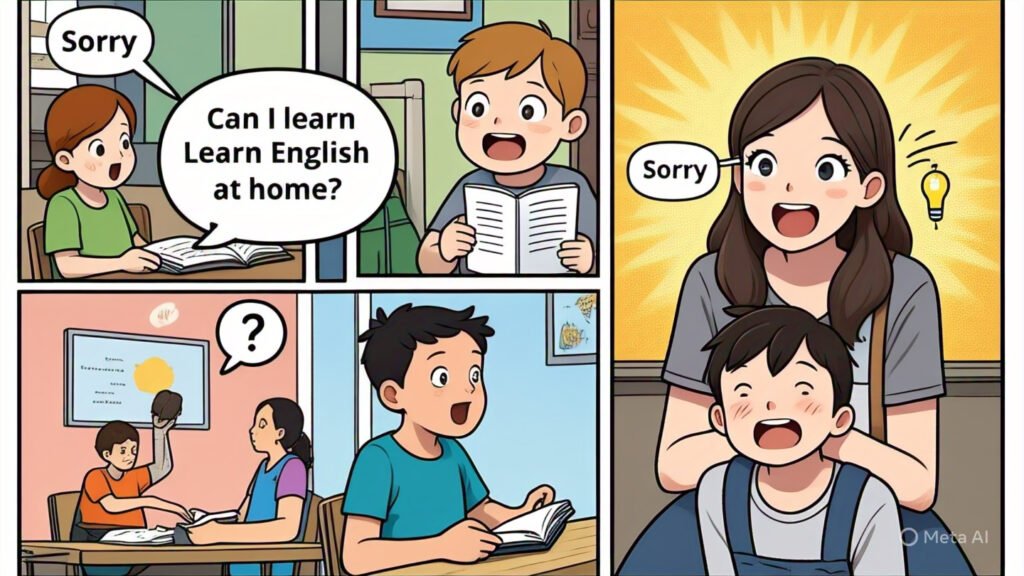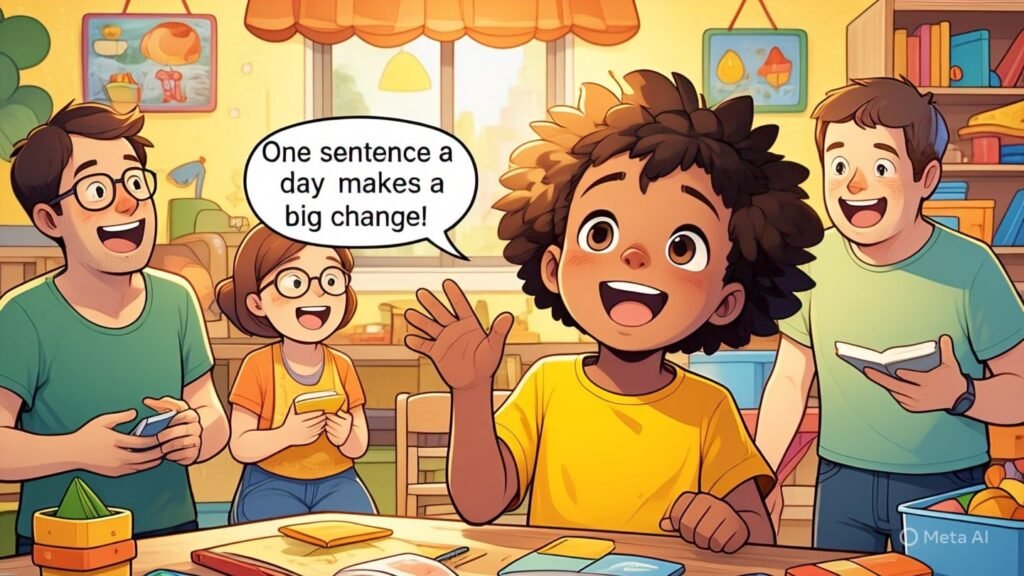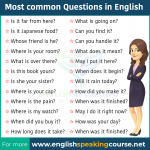Table of Contents
Toggle🟢 Introduction: Why This Guide Is Perfect for Your Child’s English Learning Journey
Learning English at an early age opens the door to confident communication, better school performance, and a strong foundation for future learning. Whether you’re a parent helping your child speak clearly, or a teacher guiding young learners, this blog post is your easy-to-follow guide filled with simple and useful English sentences for kids.
This post is designed especially for children between 3 to 10 years old, who are just starting to speak English or want to improve their everyday conversation skills. These sentences are short, practical, and easy to remember, making them ideal for real-life use at home, school, playground, or anywhere else.
As someone who has worked closely with early learners and observed the language challenges many children face, I’ve created this resource with real experience and educational care. You won’t find long grammar rules or complicated vocabulary here—just the friendly, functional English kids need to express themselves every day.
Whether your child is saying “Good morning!” for the first time, or learning to say “May I go to the park?”, this guide will support their learning with kindness, clarity, and a lot of fun.
🟢 Why Should Kids Learn Simple English Sentences?

Teaching kids to use simple English sentences early in life helps them in ways that go far beyond language. It builds their ability to express thoughts, ask questions, and interact confidently with the world around them.
🌟 1. Builds Strong Communication Skills
Children who learn to speak in full sentences early on can explain what they feel, need, or want. For example, instead of pointing or crying, a child can say, “I am thirsty” or “I want to play.” This helps parents and teachers understand them better—and helps the child feel heard.
🌟 2. Helps in School and Social Life
When kids know how to ask “May I go to the washroom?” or answer “My name is Aanya,” they feel more confident at school. They can speak with classmates, ask teachers for help, and join activities without fear.
🌟 3. Builds the Foundation for Future English Learning
Simple sentences like “This is my bag” or “Where is the ball?” are stepping stones to stronger grammar, vocabulary, and fluency. Starting with the basics now makes it easier to learn reading, writing, and speaking in higher classes later on.
🌟 4. Supports Emotional Growth
Kids often get frustrated when they can’t say what they feel. Teaching them to say things like “I am sad” or “I don’t like this” helps them express emotions in a healthy way. This improves not just language but their mental well-being too.
🌟 5. Easy to Practice Every Day
One of the biggest benefits? These sentences are easy to fit into daily life. Whether your child is eating, playing, or getting ready for school, you can help them practice short, useful sentences naturally—without pressure.
These reasons make it clear: learning English through simple, daily sentences is one of the best gifts you can give a child. It helps them not only speak better but also think better, connect better, and feel more confident—in English and in life.
🟢 Tips for Teaching English Sentences to Kids

Helping kids learn English sentences doesn’t have to feel like a classroom lesson. In fact, the best learning happens when it’s part of fun, daily routines. Here are some practical, parent- and teacher-friendly tips to make English learning easy, natural, and effective.
✅ 1. Use Real-Life Situations
Instead of teaching random words, use what’s already happening around the child. For example, at mealtime, you can teach sentences like: 👉 “I am hungry.” 👉 “Please give me water.”
When kids hear and use sentences in real life, they remember them better.
✅ 2. Speak Slowly and Clearly
Young learners need time to understand and repeat new sounds. Always speak slowly and clearly. Break longer sentences into shorter parts if needed. Example: “This is your bag” → “This… is your bag.”
✅ 3. Practice Through Repetition
Children learn by hearing the same things again and again. Repeat simple sentences every day, but in different contexts. For example: Let’s go to the park. Let’s go on a road trip. Let’s go watch a movie.
✅ 4. Use Visuals and Actions
Show pictures, use toys, or act out actions while saying sentences. For example:
Show a glass and say: “This is a glass.”
Point to your eyes and say: “These are my eyes.”
Kids remember better when they can see or do what they hear.
✅ 5. Make Learning a Game
Turn sentence practice into a fun activity. Try:
Matching games (sentence with picture)
Role-plays (pretend shopping, going to school)
Sentence-building with flashcards
Fun makes learning stress-free and helps kids stay interested.
✅ 6. Encourage, Don’t Correct Too Much
If a child says, “I hungry,” respond kindly: 👉 “Yes, say: I am hungry.” Avoid scolding. Encourage effort, and gently guide them to say it the right way.
✅ 7. Use Songs and Rhymes with Sentences
Children love music. Use short rhymes or songs that include useful sentences. E.g., “Hello, how are you? I’m fine, thank you!”
Songs improve memory and make sentence practice fun and rhythmic.
✅ 8. Be Patient and Celebrate Small Wins
Every new sentence a child learns is a step forward. Celebrate when they say: 👉 “I did it!” 👉 “Thank you, Mama!”
Give hugs, smiles, or stickers to build confidence and joy in learning.
Remember: You don’t need to be perfect in English to teach your child. Just being consistent, loving, and involved makes a big difference. 🌟
🟢 Basic Sentence Structures Kids Should Learn

Before children can speak full English conversations, they need to understand how basic sentences are built. Learning simple sentence patterns helps kids form their own sentences with ease and confidence.
Here are the most important sentence structures every child should start with:
✅ 1. “I am…” Sentences
This is one of the easiest and most powerful ways for children to talk about themselves.
Examples:
I am happy.
I am a boy/girl.
I am hungry.
I am five years old.
👉 Use these to help kids talk about their feelings, age, or identity.
✅ 2. “This is…” and “That is…”
Great for introducing objects, people, and animals in their surroundings.
Examples:
This is my book.
That is a cat.
This is my friend.
That is a chair.
👉 Use everyday objects to practice—books, toys, pets, school items.
✅ 3. Subject + Verb + Object (Simple Sentences)
This is the core sentence pattern in English and helps in describing actions.
Examples:
I eat rice.
She plays football.
He drinks milk.
We read books.
👉 These teach kids how to talk about what they or others are doing.
✅ 4. Yes/No Sentences
These are short but very useful in day-to-day talking.
Examples:
Yes, I do.
No, I don’t.
Yes, I am.
No, I am not.
👉 Use during short Q&A games or daily conversations.
✅ 5. Simple Questions
Kids love asking questions, and it’s a key part of learning English.
Examples:
What is your name?
Where is my toy?
Who is she?
How are you?
👉 Practice these using toys, pictures, or real situations at home or school.
✅ 6. Polite Sentences
Teaching manners through language helps kids become kind and respectful speakers.
Examples:
Please help me.
Thank you.
Excuse me.
Sorry.
👉 Use these while teaching good behavior in both home and school settings.
✅ 7. Everyday Commands
Children need to understand and follow simple instructions.
Examples:
Sit down.
Stand up.
Open your book.
Close the door.
👉 Teachers and parents can use these during daily routines.
These sentence patterns are the building blocks of clear, confident English speaking. When practiced regularly, they help kids create hundreds of new sentences on their own — naturally and happily.
🟢 100+ Daily Use English Sentences for Kids

Children learn best through repetition and routine. That’s why these sentences are grouped by everyday situations—so kids can use them naturally at home, school, playground, or while talking with family and friends.
🟡 A. Greetings and Introductions
These help kids start conversations politely and confidently.
Hello!
Good morning.
Good night.
What is your name?
My name is Riya.
How are you?
I am fine.
Nice to meet you.
See you later.
Bye-bye!
🟡 B. At Home
Perfect for daily talk with parents, siblings, and helpers.
I am hungry.
Let’s eat.
I want water.
I like this toy.
Where is my bag?
This is my room.
I am feeling sleepy.
Please switch on the fan.
I don’t like it.
I am ready.
🟡 C. In the Classroom
Great for school-going kids to interact with teachers and classmates.
Good morning, ma’am.
May I come in?
Please check my notebook.
I have finished my work.
Can you help me?
I don’t understand.
May I go to the washroom?
This is my pencil.
I forgot my homework.
Thank you, teacher.
🟡 D. At the Playground
Helps kids talk while playing and making friends.
Let’s play!
Come with me.
Throw the ball.
Catch it!
I want to swing.
You are it!
Don’t push me.
Wait for your turn.
Let’s go home.
That was fun!
🟡 E. Mealtime Sentences
Encourage polite table talk and healthy communication during meals.
I am hungry.
I like rice.
I don’t want more.
Please pass the spoon.
Thank you, Mama.
This is tasty!
I spilled water.
I want more juice.
Let’s eat together.
I’m full.
🟡 F. Common Questions and Answers
Useful for basic interaction and curiosity.
What is this? → This is a pen.
Who is she? → She is my sister.
Where are you going? → I am going to school.
Are you okay? → Yes, I am.
Do you like chocolate? → Yes, I do.
Can I help you? → Yes, please.
🟡 G. Polite Words and Sentences
These teach kids kindness, manners, and social behavior.
Please help me.
Thank you.
Sorry!
Excuse me.
You are welcome.
That’s okay.
It’s my turn.
Don’t be rude.
I will share.
Let’s say sorry.
🟡 H. Sentences About Feelings
Helps children express emotions clearly and respectfully.
I am happy.
I feel sad.
I am scared.
I am excited!
I don’t like loud noise.
I love my family.
I miss you.
That makes me laugh.
I am bored.
I feel shy.
These easy, short sentences give children a strong start in English communication. You can repeat them daily, act them out, use flashcards, or include them in storytelling to make practice natural and fun.
🟢 Fun Activities to Practice These Sentences

Learning English doesn’t have to feel like homework! In fact, when kids play and explore, they remember sentences more easily. Here are fun, effective, and screen-free activities to help your child or students use and repeat English sentences every day.
🎲 1. Sentence Flashcards
How to play: Write short sentences on cards like “I am happy” or “This is my toy.” Show the card and ask the child to read it aloud or act it out.
🔸 Why it works: Visual learning boosts memory. Kids also enjoy collecting or matching the cards.
🎤 2. Role-Play Games
Examples:
Act like a teacher and student: “Please check my notebook.”
Play doctor-patient: “I have a fever.”
🔸 Why it works: Kids love pretending! Role-plays give real-life practice in a fun way.
🧸 3. Talking with Toys
Use dolls, animals, or action figures and create short dialogues. Example:
Teddy: “Good morning!”
Bunny: “How are you?”
Teddy: “I am fine.”
🔸 Why it works: Kids talk more freely when using toys. It builds creativity and sentence confidence.
🎶 4. Sing-Along Sentences
Use simple songs that include common sentences. You can even make your own tunes for lines like “I want water” or “Please help me.”
🔸 Why it works: Music makes sentence rhythm easy to remember, especially for younger kids.
🎯 5. Daily Sentence Challenge
Each day, give your child 1–2 new sentences to say and use. For example:
Monday: “This is my book.”
Tuesday: “I am ready.” At the end of the day, ask them to say the sentence again.
🔸 Why it works: Daily repetition builds fluency naturally over time.
🎨 6. Draw and Talk
Ask your child to draw something and then talk about it using a sentence. Example: “This is my book.” or “This is a cat.”
🔸 Why it works: Combines art with speaking, helping visual and verbal learners at the same time.
📚 7. Story Time with Sentences
While reading a picture book, stop and ask your child to describe the picture: “What is the boy doing?” → “He is eating.” “What is this?” → “This is a cat.”
🔸 How it helps: Encouraging good habits makes it easy to keep using something regularly.
🏆 8. Reward-Based Practice
Create a sticker chart or reward box. Every time the child uses an English sentence correctly, they earn a point or sticker.
🔸 Why it works: Encouraging positivity helps build consistent habits naturally and stress-free!
These activities turn everyday moments into learning opportunities—without stress, boredom, or over-reliance on mobile screens. Just 10–15 minutes a day can help your child speak English better with happiness and confidence!
🟢 FAQs – English Sentences for Kids

❓1. At what age should kids start learning English sentences?
✅ Children can begin learning English sentences as early as 2 to 3 years old, especially if they’re exposed to the language at home or school. Start with very simple phrases like “I am happy” or “This is a ball.” The key is to use short, clear, and repeated language daily.
❓2. How many sentences should I teach my child per day?
✅ Start with 1 to 3 sentences per day, depending on your child’s age and interest. Quality matters more than quantity. Use those sentences in real-life moments so they become meaningful and easier to remember.
❓3. Can non-English-speaking parents teach their kids English?
✅ Absolutely! You don’t have to be perfect in English to support your child’s learning! Just use simple phrases and say them with love and consistency. Watching English cartoons together, repeating everyday sentences, and singing along with kids’ songs are great ways to learn together.
❓4. What’s the best way to help kids remember sentences?
✅ Use a mix of fun methods—games, songs, actions, drawings, and flashcards. Also, practice in real-life moments like eating, playing, or getting ready for school. Repetition and routine are the best tools for memory.
❓5. Are grammar rules necessary at this age?
✅ No. At early stages (ages 3–7), focus on using full, correct sentences, not teaching grammar rules. Kids learn grammar easily by listening and copying the right way to say things. For example, instead of saying, “This toy mine,” they’ll learn to say, “This is my toy,” through repetition.
❓6. How can I check my child’s progress?
✅ You don’t need tests! Instead, observe if your child:
Uses sentences on their own
Understands when you say something in English
Responds with short phrases or actions
Enjoys using English during play or daily routines
If yes, they’re learning well!
❓7. What should I do if my child makes mistakes?
✅ Mistakes are a natural part of learning. Don’t scold. Gently repeat the correct sentence. For example: Child: “I eated my lunch.” You: “Oh, you ate your lunch? That’s nice!”
Encourage confidence over perfection.
❓8. How can teachers use this blog in the classroom?
✅ Teachers can use the sentence groups for daily practice, warm-up activities, or role-playing games. You can also create sentence walls, give flashcard activities, or organize “speak and show” games to make learning interactive and fun.
🟢 Conclusion: Make English a Part of Everyday Life 🌈
Helping kids learn English sentences doesn’t mean long study hours or memorizing hard grammar rules. In fact, the best way to teach children is by using short, meaningful sentences during their daily routines—whether they’re brushing their teeth, eating dinner, or playing with toys.
Start small. Be consistent. Use fun games, kind encouragement, and loving conversations. Even one new sentence a day can make a big difference over time.
Whether you’re a parent guiding your child at home or a teacher supporting students in class, remember: 👉 Kids learn fastest when they feel happy, safe, and supported. 👉 Every “I want water” or “This is my toy” is a step toward real confidence in speaking English.




